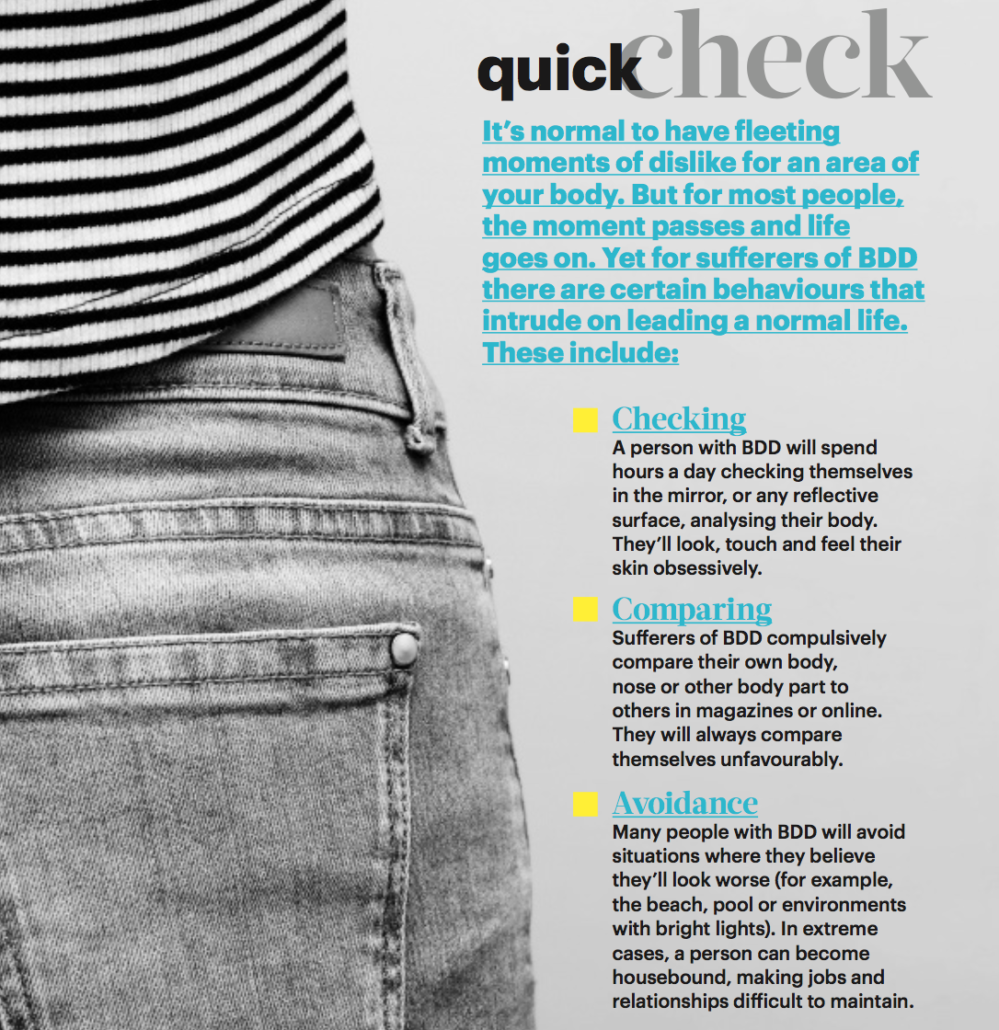Dr Ben Buchanan is a leading psychologist who specialises in the assessment and treatment of body dysmorphic disorder. He regularly appears in the media regarding body image concerns and has conducted scientific research in the area.
Do I Have Body Dysmorphic Disorder?
- Do you believe you have a “defect” in part of your body or appearance?
- Do you spend a lot of time checking this “defect?”
- Do you hide or cover up this “defect” or fix it through diets, exercise or surgery?
- Does this belief cause you embarrassment, distress, or torment?
- Does this “flaw” interfere with your ability to function at work, school or in social situations?
- Do friends and family tell you this “defect” is minor or that there is nothing wrong with you?
See the below interview with Dr Buchanan regarding treatment of Body Dysmorphic Disorder.
Treatment for Body Dysmorphic Disorder
Cognitive behaviour therapy (CBT) is training in how to change underlying attitudes in order to think and feel in different ways. This is an evidence based treatment and the primary treatment method at our clinic.“Cognitive” refers to the events that take place in your mind (thoughts, images, memories, or processes like ruminating and worry). “Behaviour” is what you do (for example escape, avoid, check). CBT starts with building a good understanding of the problem and what is keeping it going in terms of how your mind works. Very often it turns out that ‘the solution is the problem’. For example, you might examine your appearance in the mirror to try and work out ‘how do I really look?’ but rather than leaving you feeling more certain of how you look, it might leave you feeling less certain and more preoccupied.
One way of thinking about BDD is that it is a problem of ‘not being able to see the wood for the trees’ – that you can no longer make an objective assessment of your appearance because you have become so distressed and preoccupied. Because you are excessively self-focused on your felt impression, you assume that this is how others view you. This often leads to radically different opinions on your appearance between yourself and those who are close to you. Being self-focused through scrutinising and monitoring your appearance, or the reactions of others, can increase feelings of self-consciousness and make being out in social situations very uncomfortable.
During therapy, you are likely to learn to re-focus your attention away from your self and re-engage with activities that will improve your mood and your life. Many people come to view their negative self-image of their looks as a bad memory from the past, such as bullying or teasing. To help reduce self-consciousness we use specific attention-training exercises. To further fight back you will be asked to resist comparing your appearance, to stop ruminating, test out your fears without camouflage and stop rituals such as checking and excessive grooming. Many people find it helpful to think of CBT for BDD as training in how to stop being bullied by their BDD and to re-direct themselves into all the other aspects of living that are important to them. The main side effects of the treatment are the anxiety that occurs in the short term. However, testing one’s fear gets easier and easier and the anxiety gradually subsides.
Triple J Podcast: Body dysmorphia, Body Obsession and Cosmetic Surgery
What can I expect if I attend the clinic to get CBT for BDD?
- Understanding and genuine care
- A shared understanding of your main problems and goals
- A ‘formulation’ – a diagram or verbal explanation of how your BDD developed and how it is being maintained that will be tested out in therapy
- Tasks within the session for example testing some of your fears
- Agreed ‘homework’ tasks to be completed outside the sessions, and reviewed at the next session
- A strong focus upon you re-claiming your life, facing feared/avoided situations, and reducing the repetitive behaviours (e.g. comparing, checking, reassurance seeking, camouflaging and concealing)
- A clear focus upon reducing your preoccupation and distress, and improving function. Body image in BDD usually only returns to normal once the person’s preoccupation and distress have reduced and functioning has improved.
- Treatment usually takes between 10 and 20 sessions, often conducted weekly or fortnightly.
Other evidence based treatments for BDD
- Coping and management skills – training in how to cope with symptoms of anxiety. For example, the person may learn relaxation techniques and how to combat hyperventilation.
- Medications – including antidepressant medications, particularly selective serotonin reuptake inhibitors (SSRIs). These drugs help reduce many BDD symptoms, including the compulsive thoughts, depression and anxiety. Generally, medications are used in combination with CBT.

